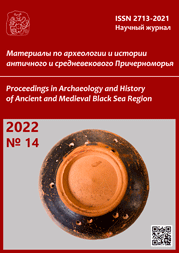Sources of metal of silver objects from burials of nomads of Asian Sarmatia of the 2nd century BCE — 3rd century CE after the results of archaeological and Pb-Pb isotopic studies
Sources of metal of silver objects from burials of nomads of Asian Sarmatia of the 2nd century BCE — 3rd century CE after the results of archaeological and Pb-Pb isotopic studies
Author(s): Mikhail Ju. Treister, Andrey ChugaevSubject(s): Archaeology, Ancient World
Published by: Нижневартовский государственный университет
Keywords: Nomads; Asian Sarmatia; silver vessels; details of armor; horse equipment; belt sets and of ceremonial furniture; typology; chronology; stylistic features; distribution; centers of manufacture; Pb iso
Summary/Abstract: The paper is devoted to the complex analysis of silver objects from the burial complexes of Asian Sarmatia of the 2nd century BCE — 3rd century CE, representing both typological and cultural-historical analysis of these items in combination with the study of the isotopic composition of Pb in order to try to answer questions not only about possible centers of the manufacture of objects, but also of the sources of the metal. Pb-Pb data were obtained using inductively coupled plasma multicollector mass spectrometry (MC-ICP-MS) carried out in the Laboratory of isotopic geochemistry and geochronology of the Institute of Geology of Ore Deposits, Petrography, Mineralogy, and Geochemistry RAS, Moscow.The overwhelming majority of the objects are dated within the 1st century BCE — 1st century CE time span. The stylistic features of the items indicate that their origin is associated with several production centers: 1) the workshops of the ancient cities of the North Pontic region, first of all, the Bosporan Kingdom; 2) workshops located in Asia Minor or in the Eastern Mediterranean; 3) round-bottomed goblets and some of the phalerae of horse-harness should be attributed to the products of Sarmatian craftsmen, most probably manufactured both in the Lower Volga and in the Kuban region; 4) a neck guard of the helmet of the East Celtic type, secondary used as a breastplate of horse-harness, is undoubtedly the product of the Celtic (Taurisci) workshop, located in the territory of modern Slovenia.The 17 silver items demonstrate substantial heterogeneity in terms of the Pb isotopic composition. The values of 206Pb/204Pb, 207Pb/204Pb and 208Pb/204Pb ratios vary in the ranges: from 18.07 to 19.41, from 15.60 to 15.75, and from 38.3 to 40.4 respectively. The large variation (ν206/204 = 1.4%, ν207/204 = 0.2%, and ν208/204 = 1.2%) can be explained by the origin of the metal from several ore provinces located in the Black Sea region, Asia Minor and the Near East. The Pb isotopic composition of most of the items is consistent with deposits in the Black Sea region — Eastern Balkans (6 items) and Eastern Pontides (6 items). The Pb-Pb data indicates that silver also could come from the deposits of the Taurus (South-Eastern Turkey) and Zagros (Western Iran) Mountains
Journal: Материалы по археологии и истории античного и средневекового Причерноморья
- Issue Year: 2022
- Issue No: 14
- Page Range: 85-139
- Page Count: 65
- Language: English

